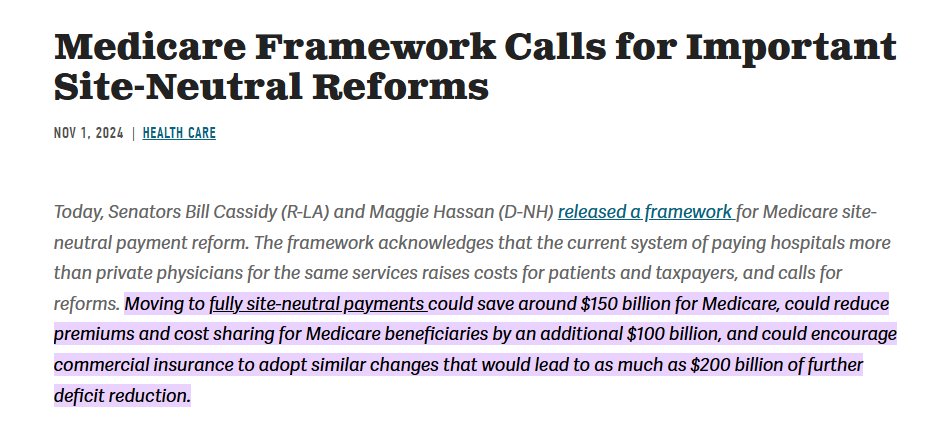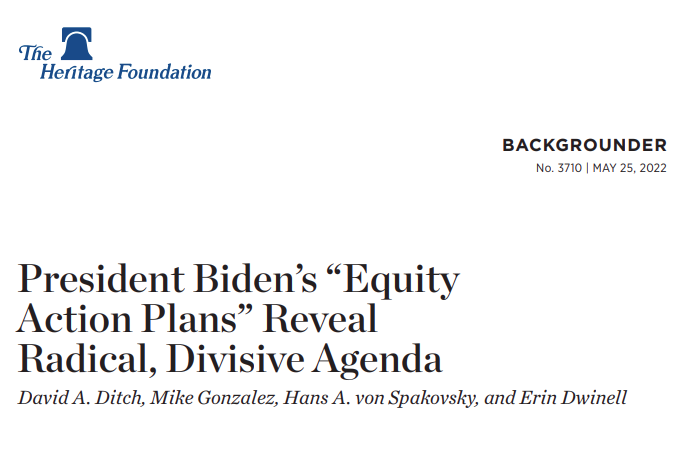Last year's obscenely bloated omnibus spending bill is a big source of discontent among House conservatives. Since the spending debate is only just beginning, I'm going to highlight 23 of the worst FY 2023 earmarks over the next several weeks. MEGATHREAD: (1/x)
https://twitter.com/DavidADitch/status/1605102741617086464
Today's earmark is $500,000 for upgrading a skate park in Burrillville, Rhode Island, which was requested by Rep Langevin with support from Sen Whitehouse.
Burrillville, population 16k, is located about 20 miles northwest of Providence and seems like a perfectly nice town. (2/x)
Burrillville, population 16k, is located about 20 miles northwest of Providence and seems like a perfectly nice town. (2/x)

The current skate park is nothing to write home about, which you'd expect since a town is only going to pay so much to support a recreational activity that only so many local kids participate in.
That's where federal taxpayers come in.(3/x)
That's where federal taxpayers come in.(3/x)
Since the people of Burrillville are apparently not interested in paying for a better skate park entirely on their own dime, their elected officials lobbied Congress for a handout.
But why is the federal government getting involved? (4/x)
But why is the federal government getting involved? (4/x)
The reasoning is simple: the Community Development Fund program provides "free" federal money for local projects such as this. Burrillville officials will take credit without raising local taxes, while Langevin and Whitehouse take credit for bringing home the bacon. (5/x)
Meanwhile, the teens who will use the skate park face a mountainous federal debt. The dirty secret is that "free" federal money comes with a price, but politicians always expect they won't suffer consequences for running up the national credit card. (6/x) 

The inclusion of projects like this in the omnibus package at a time of $1 trillion+ deficits and an unsustainably growing debt signals that Congress does not take the situation seriously. They should focus federal resources on core responsibilities, but refuse to. (7/x)
Bottom line: Burrillville should pay for its own skate park upgrade. If they don't want to, that says it isn't worth the cost. (8/x)
The next earmark is $2 million for upgrading the National Great Blacks in Wax Museum in Baltimore, MD, requested by Rep. Kweisi Mfume with support from Senators Cardin and Van Hollen.
greatblacksinwax.org (9/x)
greatblacksinwax.org (9/x)

Rep. Mfume was first elected to the House in 1987, was President of the NAACP from 1996 through 2004, then returned to the House in 2021. In that time I assume he has amassed a tremendous rolodex of high-profile contacts.
en.wikipedia.org/wiki/Kweisi_Mf… (10/x)
en.wikipedia.org/wiki/Kweisi_Mf… (10/x)
Could those contacts, in conjunction with the museum's existing patrons, have covered the expense of the museum upgrade without involving federal taxpayers, the overwhelming majority of whom will never visit the museum? (11/x)
Museums are a classic example of federal pork spending: projects that are highly visible locally, but that local officials would prefer not to fully budget for. So they seek a freebie from Uncle Sam's Community Development Fund. (12/x)
Great Blacks in Wax is one of several museums receiving millions in federal funding through the omnibus earmarks. Another even more egregious example is coming soon. (13/x)
Our 2023 earmark journey resumes in Caribou, Maine, located perilously close to the Canadian border. Sen. Collins, who is taking over as the top Republican on the Senate Appropriations Committee, secured $4.459 million in federal funding for a pond project. (14/x) 

What's the project? To learn that we have to visit Sen. Collins' website. Apparently we're paying to excavate the pond and redo a dam for the purpose of encouraging trout and waterfowl.
collins.senate.gov/newsroom/nearl… (15/x)
collins.senate.gov/newsroom/nearl… (15/x)

It would be one thing if this was a project with a huge ecological impact, but it isn't. This is mainly about making the town more pleasant/scenic. And Caribou isn't just any town; it's Sen. Collins' hometown! collins.senate.gov/about/susan-co… (16/x)
Caribou has a population of 7,396, down 40% since 1960. That doesn't inherently mean that the project is a bad idea, but it does mean that Caribou might have a hard time paying for a massive overhaul of the pond. To get around that problem, the rest of us are paying. (17/x)
There is no substantial justification for federal involvement in a pond excavation. Perhaps the people of Caribou can't afford the $4.459 million cost. However, the federal government can't afford it either. (18/x) 

Today's absurd earmark from last month's bloated omnibus is the Door County Granary in Wisconsin, which will get $3.3 million due to Sen. Baldwin's request. This is a museum project I consider more ridiculous for federal taxpayers than last week's "Great Blacks in Wax". (19/x) 

Built in 1901 as a grain elevator in the city of Sturgeon Bay, the Granary is a focal point for the local historical society. They want to renovate and preserve the site as an homage to the area's pastoral roots.
sturgeonbayhistoricalsociety.org/granary (20/x)
sturgeonbayhistoricalsociety.org/granary (20/x)
Considering what would make a museum a serious attraction, there are a few key elements. Is it located next to a big city? If not, is it located near a high-traffic road? If not, is it something people would travel hundreds of miles to visit? (21/x) 

In the case of the Granary, the answer to all three is a resounding "no".
-Green Bay is a healthy city, but not a megalopolis.
-Sturgeon Bay is located halfway up a peninsula that has a combined population of 30k.
-A farm museum is not a destination attraction. (22/x)
-Green Bay is a healthy city, but not a megalopolis.
-Sturgeon Bay is located halfway up a peninsula that has a combined population of 30k.
-A farm museum is not a destination attraction. (22/x)

This is a local history project and it's getting praise for architectural plans. If the residents of the area think it's worthwhile, great. But as you'll see, the locals don't actually seem to believe it's worth the cost! (23/x)
A FAQ says the plan was to fund the Granary from private donations and foundation grants, NOT local taxpayers. I can't find how much they raised, but the website mentions a few grants of $100k each. A story from April 2022 references a $3 million estimated cost. (24/x) 



The earmark is for $3.3 million. So while they're keeping local taxpayers safe, the overwhelming majority of the Granary's cost is passed onto the rest of the nation, at a time when we're staring down $1 trillion deficits as far as the eye can see. (25/x) 
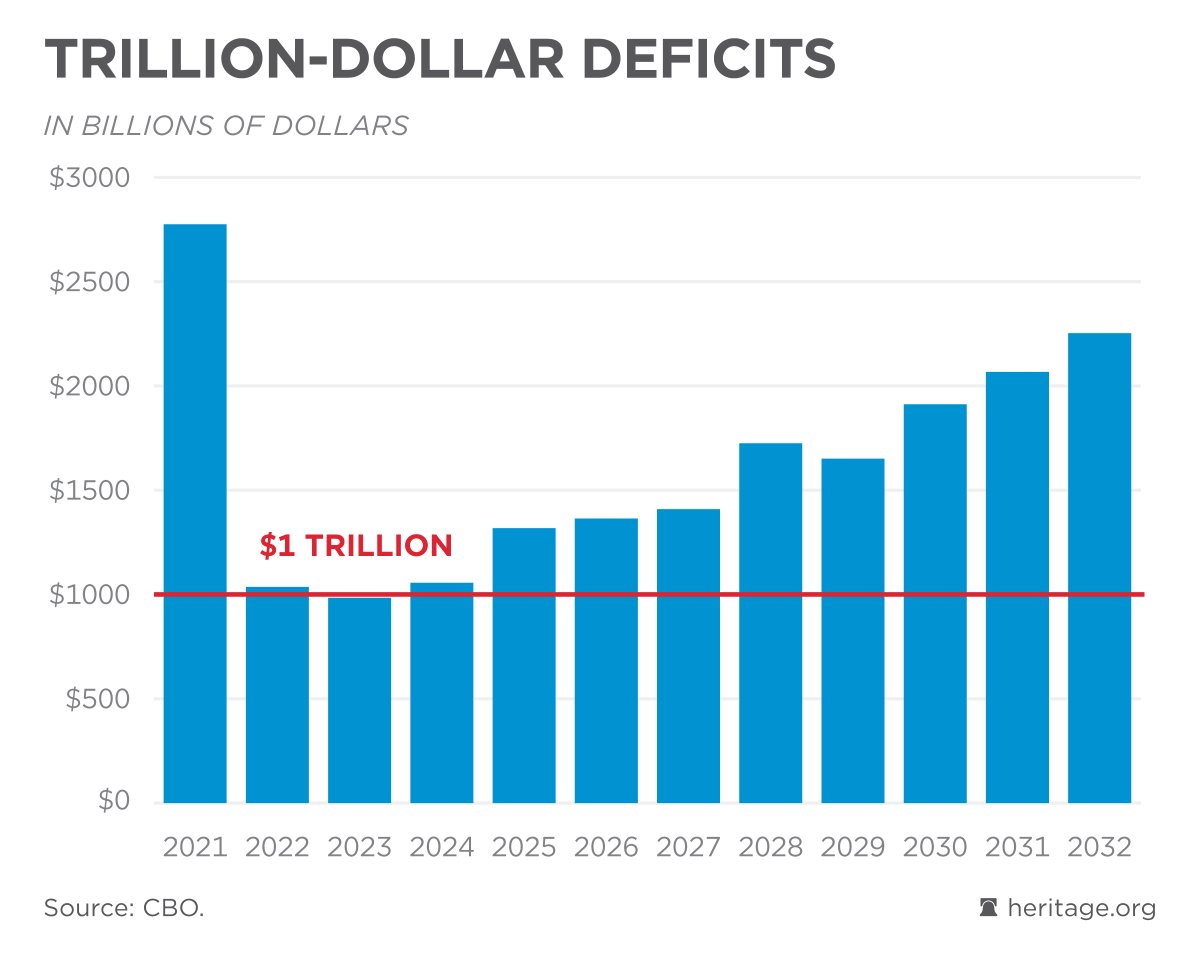
Sen. Baldwin gets to appear generous to the people of Sturgeon Bay by gifting them a farm museum. But is it true generosity when she's using other people's money?
Of course not. It's wasteful and corrupt. (26/x)
Of course not. It's wasteful and corrupt. (26/x)
Thursday's 2023 earmark has layers, so stay with me to the end.
Rep. LaHood and Sen. Duckworth got $3.5 million for "rehabilitation" of a rather short stretch of a local road, using an approach I call Woke Infrastructure. (27/x)
Rep. LaHood and Sen. Duckworth got $3.5 million for "rehabilitation" of a rather short stretch of a local road, using an approach I call Woke Infrastructure. (27/x)

What made this initially stand out to me from other Woke Infrastructure earmarks is that it has bipartisan support, rather than just coming from a Democrat. Indeed, Rep. LaHood is quite comfortable advertising his support for "equity", the progressive buzzword of the day. (28/x) 

Infrastructure "equity" means spending on things relatively few people use: bike lanes, transit, etc.
While it can make sense locally, there's no reason for federal funds to get involved unless you're trying to pass the cost on to someone else. heritage.org/transportation…
(29/x)
While it can make sense locally, there's no reason for federal funds to get involved unless you're trying to pass the cost on to someone else. heritage.org/transportation…
(29/x)
The project gets worse when we look at *where* this "equity" "multi-use path" is going: from 150 (Rivian Motorway) on the left, to White Oak Rd on the east, just before the highway. Less than two miles for $3.5 million. Further west is fields. (30/x) 

What's really going on here? Why do Rep. LaHood and Sen. Duckworth care about adding to this small stretch of road? We zoom in and see that on the left side is a big industrial building. Whose building? (31/x) 

Answer: Rivian, an electric vehicle manufacturer. The largest shareholders are Amazon, Abdul Latif Jameel (a Saudi business group), and Ford.
We're paying $3.5 million to make it easier for people to walk/bike to the Rivian plant from the residential area to the east. (32/x)
We're paying $3.5 million to make it easier for people to walk/bike to the Rivian plant from the residential area to the east. (32/x)

If there's going to be a $3.5 million "multi-use path" to the Rivian plant, how about Rivian ($22 billion in assets) pay for it directly (or indirectly through taxes to the local government)? Federal taxpayers heavily subsidize Rivian's product, isn't that enough? (33/x)
This earmark is one policy problem on top of another: inappropriate federal spending on a local project to benefit a politically privileged business. A sandwich of Woke Infrastructure and crony capitalism.
And yet there are worse earmarks to come. (34/x)
And yet there are worse earmarks to come. (34/x)
We return to Rhode Island for our next 2023 earmark: $477,000 requested by Sen. Whitehouse for teachers to receive "professional development" from the Equity Institute.
As I'll show, we're paying them to indoctrinate teachers with Critical Race Theory. (35/x)
As I'll show, we're paying them to indoctrinate teachers with Critical Race Theory. (35/x)

The Equity Institute seeks to "promote and support the development of antiracist educators, schools and educational communities". Their website is a cornucopia of progressive buzzwords, and the key term is "antiracist".
theequityinstitute.org/about/ (36/x)
theequityinstitute.org/about/ (36/x)

The Equity Institute views schools as "oppressive systems" for racial minorities, apparently even in places like deep-blue Rhode Island. They obsess about "structural and institutional racism" and want to "dismantle systems".
(37/x)
(37/x)
What on earth does all of that actually *mean*? What is "antiracist"? (Image from their Facebook page)
It's not about fairness, or about assisting children from underprivileged backgrounds. It's about promoting Critical Race Theory. (38/x)
It's not about fairness, or about assisting children from underprivileged backgrounds. It's about promoting Critical Race Theory. (38/x)
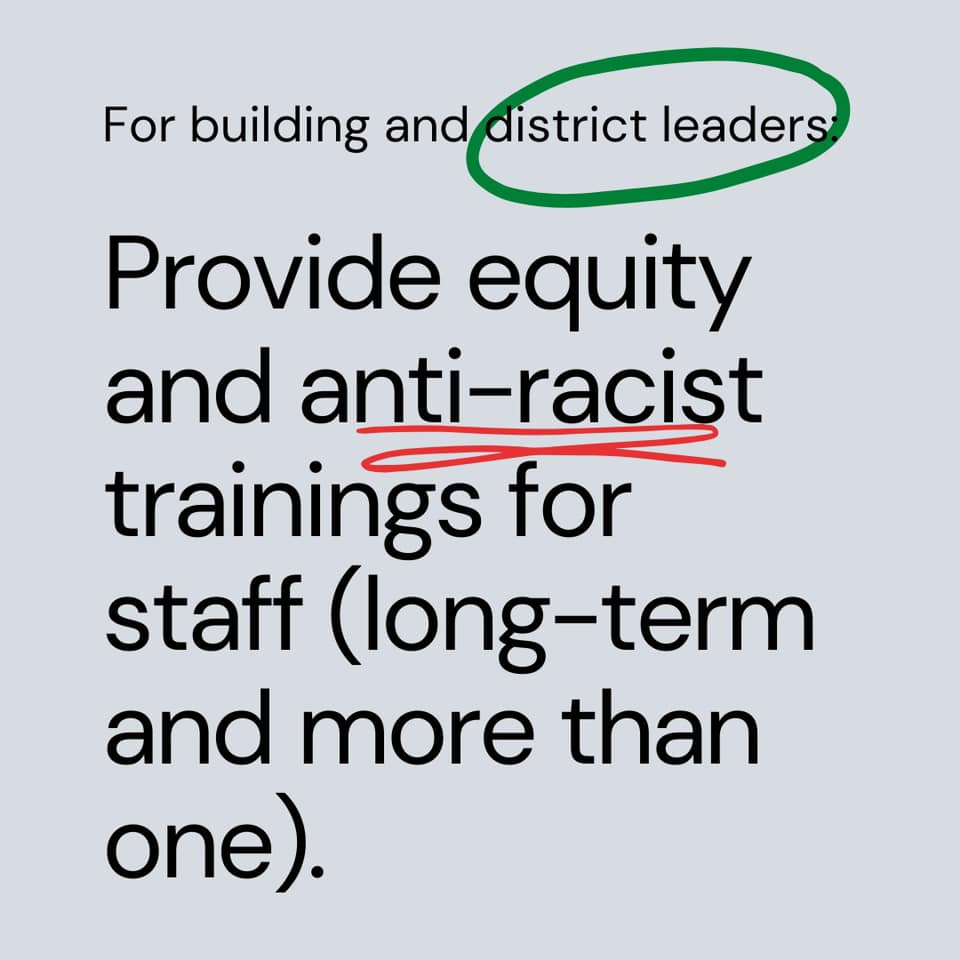
Critical Race Theory views most aspects of American culture/society as an oppressive system that needs to be dismantled. My colleagues @Gundisalvus and @JM_Butcher delved deeply into CRT in a 2020 paper: heritage.org/civil-rights/r… (39/x)
The Equity Institute camouflages the most controversial aspects of CRT in their publicly available materials, but there are more than enough hints to demonstrate that they are solid left-wing activists. (40/x)
It's one thing if a progressive school district in Rhode Island wants to bring in a progressive group like the Equity Institute to do training for teachers.
It's another thing entirely to make taxpayers from around the country subsidize CRT through an earmark.(41/x)
It's another thing entirely to make taxpayers from around the country subsidize CRT through an earmark.(41/x)
A vast network of progressive activist groups access taxpayer funds through a variety of federal grant programs, which help to fund the infrastructure of the left. Earmarks like this are only the tip of the iceberg.
(42/x)
(42/x)
The recently signed omnibus package had an earmark to devote $1.5 million to promote eating outdoors in Pasadena, CA, thanks to Rep. Chu. On the surface it seems patently absurd. When we dig down it's a mix of absurdity, pandering, and corporate welfare. (43/x) 

Many cities accommodated restaurants using public street/sidewalk areas for outdoor dining during the pandemic, since there was less foot/car traffic and many people were leery of indoor dining. This made even more sense in SoCal given the pleasant weather. (44/x)
A partnership between the city government and restaurants for continued/permanent outdoor dining infrastructure, *mostly funded by the restaurants who benefit from it*, would seem perfectly reasonable to me. But that isn't what's happening. (45/x)
Here's the project description from Rep. Chu's website, along with CDC data of the COVID case trend over the last 15 months.
According to Rep. Chu, federal taxpayers need to subsidize outdoor dining Because COVID. (46/x)

According to Rep. Chu, federal taxpayers need to subsidize outdoor dining Because COVID. (46/x)


The reality is that people like being outdoors in southern California, and Pasadena officials and restaurants found a way to shake down Uncle Sam for a handout by citing hypochondriacs. (47/x)
There are indeed people who remain deathly afraid of things like indoor dining. Their existence does not justify $1.5 million in corporate welfare for restaurants in Pasadena. Spending requests like this should be laughed out of the room, not rubber-stamped. (48/x)
Another day, another terrible 2023 earmark. We're going to Missouri, where the now-retired Sen. Blunt directed $5 million to the Ozark Empire Fairgrounds.
A straight-up handout to a recreational facility. Adding to the national debt is fun! (49/x)
A straight-up handout to a recreational facility. Adding to the national debt is fun! (49/x)

Here's how Blunt's office justified the $5 million.
"Economic development" is almost always code for "we don't trust people and businesses to make the right decisions, so we're going to give a taxpayer-funded handout to this politically connected special interest." (50/x)
"Economic development" is almost always code for "we don't trust people and businesses to make the right decisions, so we're going to give a taxpayer-funded handout to this politically connected special interest." (50/x)

This isn't even the first bucket of federal cash that Ozark Empire is receiving. They got another $5 million through the state government slush fund created by the March 2021 stimulus package. (51/x) 

Here's a 2011 Sen. Blunt speech about the nation's perilous fiscal situation, especially the risk of programs like Social Security going bankrupt. The debt has more than doubled since then, yet he was a reliable vote for bipartisan spending deals.
c-span.org/video/?300444-… (52/x)
c-span.org/video/?300444-… (52/x)
$5 million for a fairground does not make or break the federal government's finances. Rather, it points to members who don't take budgeting seriously and are more interested in handing out favors than being responsible stewards of taxpayer resources. (53/x)
Thursday's earmark spotlight shines on $2 million for "B-360 Educational Campus" in Baltimore, by way of Maryland's senators. As usual, we must do some detective work to understand what's going on here. (54/x) 

Senator Cardin's website tells us that B-360 is building a "multi-use facility" that will include "job and career training programs". But those are secondary/tertiary aspects of the project, which is primarily about Baltimore's dirt bike culture. (55/x) 

Baltimore has a longstanding problem with teens and young adults riding dirt bikes on public streets despite a ban. Here's a 2012 piece from Vice, along with a local article from last year.
vice.com/en/article/3b5…
foxbaltimore.com/news/local/the… (56/x)
vice.com/en/article/3b5…
foxbaltimore.com/news/local/the… (56/x)
Since the local government hasn't solved the problem, the people behind B-360 have sought to divert wheelie-obsessed youth into something more constructive. Will it work? Maybe. nextcity.org/features/in-ba… (57/x)
What's not clear to me is why Baltimore's dirt bike enthusiasts deserve a handout from Uncle Sam. Make that *handouts*, since they received $1.25 million from the March 2021 stimulus package, which included a slush fund for states. So a combined $3.25 million. (58/x) 

Many politicians view federal funds as free money. This is especially the case if it's debt-financed, because that avoids the thorny problem of unpopular tax hikes and pushes the problem onto today's and tomorrow's children, who can't vote yet. (59/x)
Teens using the "free" dirt bike facilities at B-360 are likely unaware of the tidal wave of federal debt bearing down on them. But it's coming none the less. (60/x) 

Patrick Leahy became a Senator in 1975 and just left office at age 82. While not as aggressively socialist as his counterpart Sanders, Leahy was still perfectly comfortable redistributing private resources, as we will see with this $12 million earmark for Burlington, VT. (61/x) 

It takes some hunting to track down a project description: helping people walk to the Church Street pedestrian mall. That doesn't sound like a $12 million project, and it only gets worse as we examine the details. (62/x) 

This picture of the Church Street mall area gives a good sense of Burlington, which is an older city anchored by a university. Burlington is growing but not especially quickly, so I'm skeptical about the need for "generational" spending on pedestrian infrastructure. (63/x) 

That skepticism turned to disbelief when I saw how small an area this project covers. Cherry Street is just 0.4 miles long! Ground level view shows it's not an arterial road or major thoroughfare with tons of traffic such that might people risk their lives to cross it. (64/x) 

But wait! You might have noticed the "pit" in the middle of Cherry Street on the map. What's the deal there?
Answer: a big development project called CityPlace Burlington, with apartments and ground-level retail, set to open in the next year. cityplaceburlington.com (65/x)
Answer: a big development project called CityPlace Burlington, with apartments and ground-level retail, set to open in the next year. cityplaceburlington.com (65/x)

Federal taxpayers have to cough up $12 million to make sidewalks and crossings nicer for people who will move into a new apartment building close to a pedestrian mall. Not Burlington, not the mall, not the apartment developers, but everyone else in the country. (66/x)
Politicians shave off millions to deliver big gifts to selected groups or areas thousands of times a year through federal programs, counting on taxpayers not noticing because the cost is spread across everyone in the country.
It's corrupt, and it needs to stop. (67/x)
It's corrupt, and it needs to stop. (67/x)
Many conservatives will look at an earmark that spends $3.6 million on a walking trail named after Michelle Obama (courtesy of Rep. Hank Johnson) and see it as wasteful because of the name. That's only a superficial start of the problems. (68/x) 
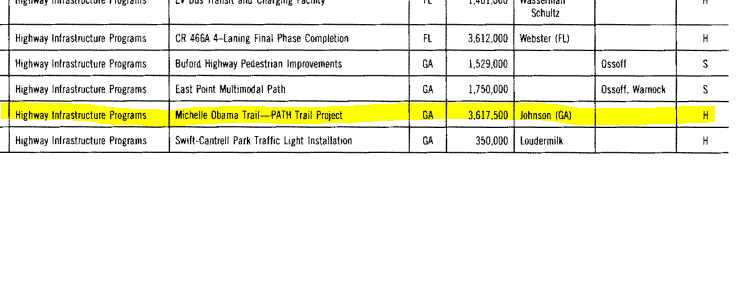
The project was requested by the DeKalb County government. While we normally think about lobbying coming from businesses, a major source of lobbying activity is state and local governments who want "free" federal money for dubious projects like this. (69/x) 

You might notice that this trail is part of the "highway infrastructure program" and wonder what's going on. The answer is that the left has stapled expensive carve-outs to highway legislation that fund walking trails, bike lanes, transit, etc. heritage.org/transportation… (70/x)
The Highway Trust Fund, which is supposed to be self-funding through the federal gas tax, was driven into insolvency as a result of the non-highway add-ons. Now, the fund runs a big deficit that requires regular bailouts, which in turn adds to the national debt. (71/x) 

So not only are federal taxpayers forced to fund a trail honoring Michelle Obama in a state she has no real connection to, but the trail is also part of a major (and worsening) federal dysfunction. This nonsense has serious consequences. (72/x)
Senators Carper and Coons of Delaware teamed up to throw $6.8 million of our money at the REACH Development Corporation for its "Real Estate Strategy to Obtain Racial Equity" program. There's A LOT to unpack here.
reachriverside.org (73/x)
reachriverside.org (73/x)

The project is described as redevelopment of blighted buildings. On the surface that sounds like a good thing. In the hands of the activist left that's much less straightforward, because it's attached to the causes of racial grievance and thinly veiled socialism. (74/x) 

Housing prices have skyrocketed over the last few decades. The primary factor is government-imposed controls over housing development in nearly every high-demand area. The venerable @salimfurth has banged this drum for a while: heritage.org/government-reg… (75/x)
Rather than having government just get out of the way and allow markets to work, a portion of the left is convinced that only highly-regulated and heavily-subsidized housing is tolerable, replacing one form of government straightjacket with another. (76/x) 

The "racial equity" component of the earmark is notable because minorities in urban areas stand to benefit tremendously from a reduction in housing prices that would come from a private sector construction boom, but of course that's not what this project entails. (77/x)
Because progressive activists see the private sector as an oppressive force, the only solution for "racial equity" in housing involves lots of progressive jargon, price controls, and taxpayer subsidies.
Which raises another important point: this is a money pit. (78/x)
Which raises another important point: this is a money pit. (78/x)
REACH Development Corporation received federal support through the Paycheck Protection Program, $25 million through the slush fund given to the state of Delaware as part of the March 2021 stimulus package, and now another $6.8 million with the earmark. (79/x) 

This earmark combines socialist economic fallacies, progressice identity politics, needless federal involvement in a local project, and deficit spending. Truly a marvel to cram so many mistakes into a single line item of the omnibus. (80/x)
The omnibus contained a $3 million gift to the forthcoming American LGBTQ+ Museum in New York, requested by Rep. Nadler along with Senators Schumer and Gillibrand.
Let's dive into the well-financed network of progressive non-profits to see what's really going on here. (81/x)
Let's dive into the well-financed network of progressive non-profits to see what's really going on here. (81/x)
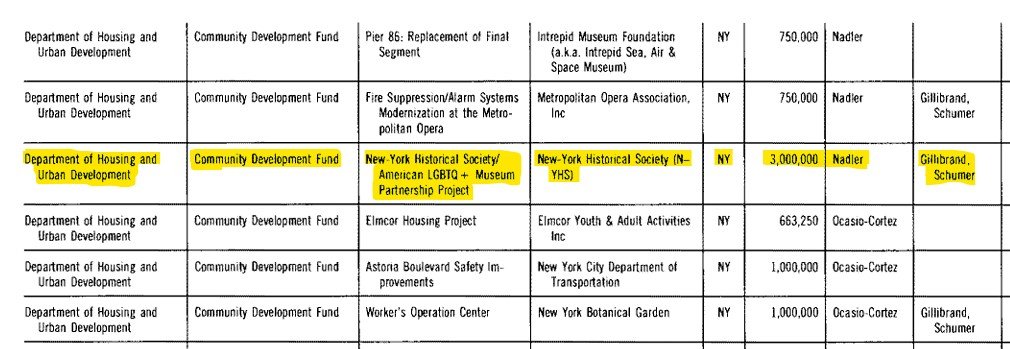
The NY Historical Society is the direct recipient of the $3 million earmark, used for a building expansion. It has $182 million in assets thanks to its network of donors, including nonprofit foundations and major corporations such as Bank of America and JP Morgan Chase. (82/x) 





The LGBTQ+ Museum's main initial sponsor was the Fund for the City of New York, which in turn was an offshoot of the Ford Foundation. I can't immediately track down financial info on the Fund for NY, but the Ford Foundation is absolutely LOADED: $20 billion in assets. (83/x) 



The LGBTQ+ Museum has a number of "institutional" sponsors, including the Johnson & Johnson Family Foundation, the Ford Foundation, and the Fund for the City of New York. (84/x) 

So: the NY Historical Society, which has substantial assets and a healthy donor network, receives $3 million from taxpayers across the nation so that it can give space to the LGBTQ+ Museum, which has its own donor network. (85/x)
Oh, and by steering $3 million to the LGBTQ+ Museum, Schumer, Gillibrand, and Nadler improve their standing with the network of high-powered progressive donors - using our money.
The corruption becomes plain as day with a little digging. (86/x)
The corruption becomes plain as day with a little digging. (86/x)
• • •
Missing some Tweet in this thread? You can try to
force a refresh




